The most advanced planetarium
In October, the most technologically advanced planetarium in the world opened its doors. It is located at the California Academy of Sciences and looks more like an ultra-modern IMAX cinema - with comfortable seating, a Dolby 5.1 system, and a giant spherical screen that surrounds the viewer from all sides. This is understandable, because the beauty of the cosmos is not inferior to the most large-budget blockbusters, so the entourage needs an appropriate one. The construction of the spherical building of Morrison Planetarium cost $ 20 million.
The planetarium is packed with modern digital equipment that can render three-dimensional video in real time, transferring viewers from one corner of space to another.
The hall is designed for 300 seats, and the rows of chairs are angled at 30 degrees, approximately as in IMAX.
')

The entire graphic and projection subsystem is based on three key elements.
1. DigitalSky program from Sky-Skan (instant visualization of individual planets and space objects with the press of a button during a presentation, zooming and navigating through 3D-models using a mouse or joystick);
Here is a DigitalSky control panel. You may notice separate buttons for zooming to specific planets.
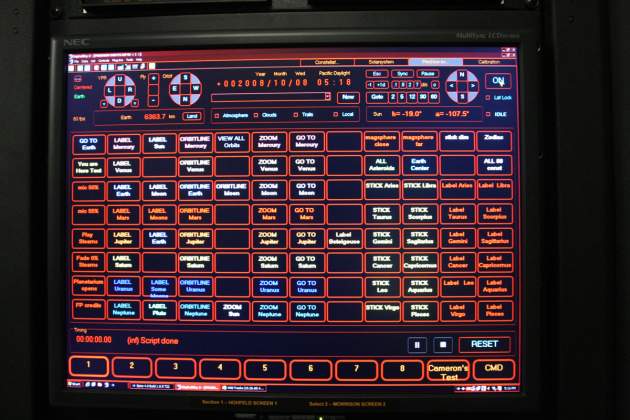
2. Global Immersion is a hardware subsystem that provides video output at 30 fps, the content is stored in the Pixar corporate format, six Norwegian Projection Design F30 projectors are used for visualization (the maximum resolution is 1920x1200, in reality they work at 1400x1050, but the planetarium plans to buy in the future projectors with a resolution of 4096x2160).
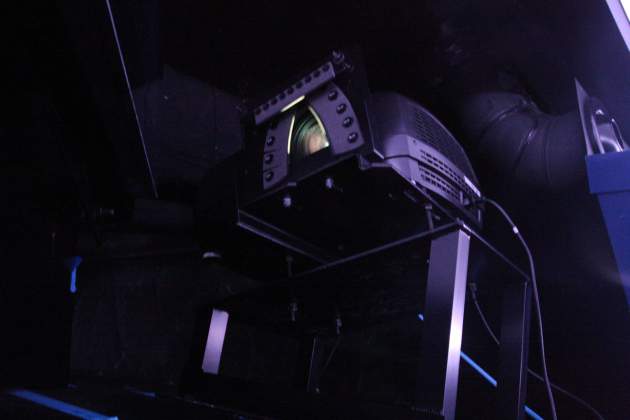
3. Cluster Uniview from the Swedish company SCISS AB. This is the most important computer subsystem and the main center for recording, storing, editing and rendering presentations.
Each of the subsystems runs on seven servers: one for each projector and one for management. The Uniview cluster has HP XW8600 workstations with dual-core Xeon and Nvidia Quadro FX5600 graphics cards.
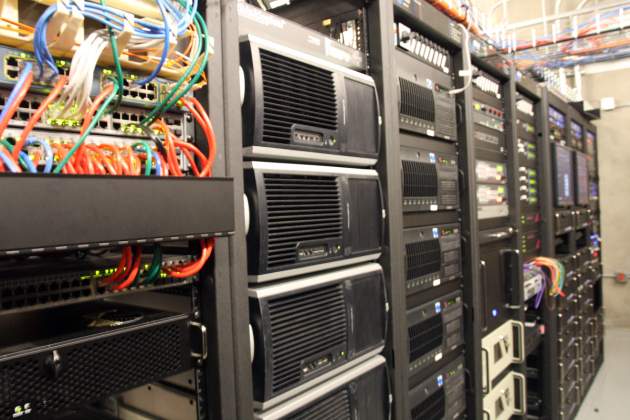
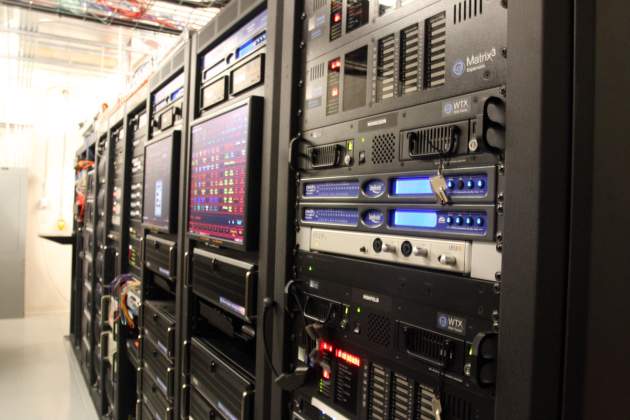
The whole farm runs on OpenGL under Windows XP, and there are no plans to upgrade to Vista or something else.
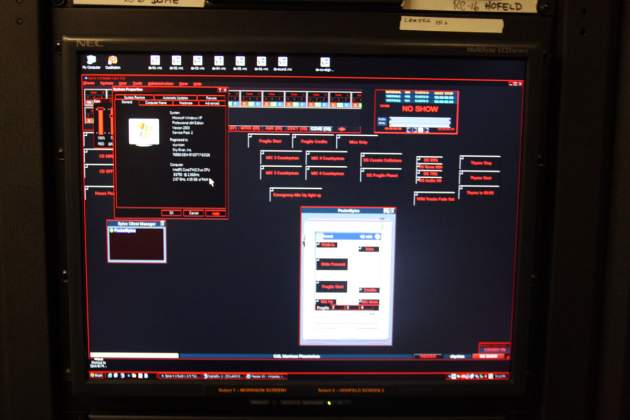
Generally speaking, this is almost the only presentation platform in the Academy of Sciences that runs on a standard PC platform. For other, ordinary, presentations are used Mac Mini.
One of the programs developed by the Academy of Sciences is the 25-minute show Fragile Planet. It begins with the fact that the walls of the planetarium disappear around the audience. They become transparent, as it were, and viewers see the surrounding space (of course, this video). Then begins the flight over the territory of the Academy of Sciences.
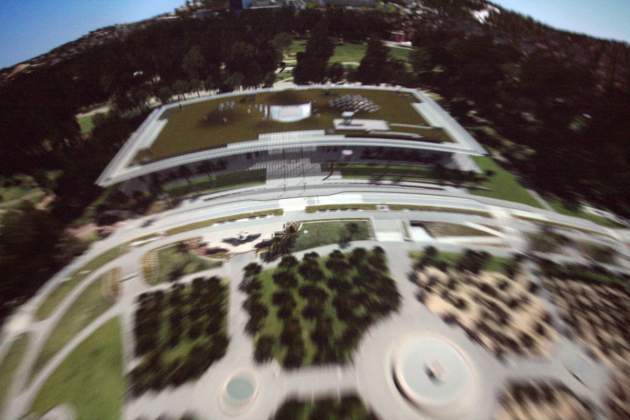
We take off higher and higher above the ground and gradually transfer to space.


Interestingly, scientific information from satellites can be loaded into the program almost in real time (for example, from the CineGrid system). Data is visualized on local workstations and instantly displayed on the screen.

Latest scientific information comes in via a 10-gigabit local area network.
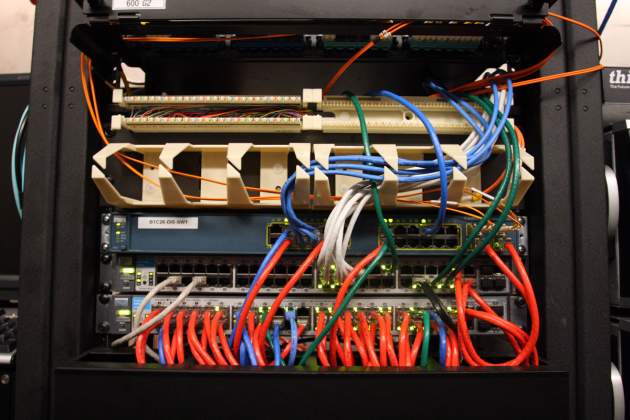
The planetarium is packed with modern digital equipment that can render three-dimensional video in real time, transferring viewers from one corner of space to another.
The hall is designed for 300 seats, and the rows of chairs are angled at 30 degrees, approximately as in IMAX.
')

The entire graphic and projection subsystem is based on three key elements.
1. DigitalSky program from Sky-Skan (instant visualization of individual planets and space objects with the press of a button during a presentation, zooming and navigating through 3D-models using a mouse or joystick);
Here is a DigitalSky control panel. You may notice separate buttons for zooming to specific planets.

2. Global Immersion is a hardware subsystem that provides video output at 30 fps, the content is stored in the Pixar corporate format, six Norwegian Projection Design F30 projectors are used for visualization (the maximum resolution is 1920x1200, in reality they work at 1400x1050, but the planetarium plans to buy in the future projectors with a resolution of 4096x2160).

3. Cluster Uniview from the Swedish company SCISS AB. This is the most important computer subsystem and the main center for recording, storing, editing and rendering presentations.
Each of the subsystems runs on seven servers: one for each projector and one for management. The Uniview cluster has HP XW8600 workstations with dual-core Xeon and Nvidia Quadro FX5600 graphics cards.


The whole farm runs on OpenGL under Windows XP, and there are no plans to upgrade to Vista or something else.

Generally speaking, this is almost the only presentation platform in the Academy of Sciences that runs on a standard PC platform. For other, ordinary, presentations are used Mac Mini.
One of the programs developed by the Academy of Sciences is the 25-minute show Fragile Planet. It begins with the fact that the walls of the planetarium disappear around the audience. They become transparent, as it were, and viewers see the surrounding space (of course, this video). Then begins the flight over the territory of the Academy of Sciences.

We take off higher and higher above the ground and gradually transfer to space.


Interestingly, scientific information from satellites can be loaded into the program almost in real time (for example, from the CineGrid system). Data is visualized on local workstations and instantly displayed on the screen.

Latest scientific information comes in via a 10-gigabit local area network.

Source: https://habr.com/ru/post/43033/
All Articles